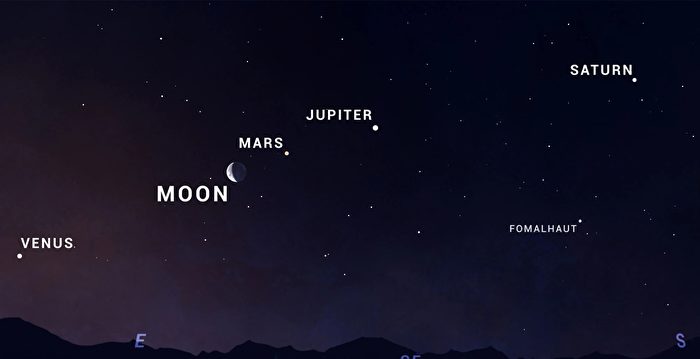[Epoch Times, June 9, 2022](The Epoch Times reporter Li Yan comprehensive report) For the first time in 18 years, the five brightest planets in the sky will be closely aligned, forming a so-called “planet parade” astronomical spectacle. They use the sun as their starting point and form a perfect arc across the sky in the correct order from near to far.
At every dawn in June, stargazers can see Mercury, Venus, Mars, Jupiter and Saturn, according to Sky and Telescope magazine, published by the American Astronomical Society. Saturn) the arc formed by the five planets in the sky.
The magazine called the astronomical sight a “planetary parade.” To see them, stargazers do best to catch a glimpse of them near the eastern and southeastern horizons an hour or a half before sunrise. When the sun rises, the sight will disappear with it.
No special equipment is required to see this astronomical spectacle, but if you can use a telescope or local observatory, the view will be much wider. Binoculars can also help improve the stargazer experience.
Diana Hannikainen, the Astronomy magazine’s observations editor, told NPR that these planetary alignments are not “incredibly rare.” The last time these planets appeared in a row was in 2004, and the next time they will appear again in 2040.
“But it’s rare enough that if we get a chance to walk outside in the morning, it’s worth it,” she said.
Venus, Mars, Jupiter and Saturn should be easily visible throughout June. Mercury is relatively difficult to spot, as it will officially join the lineup by appearing on the horizon an hour before sunrise on June 24.
Before that, seeing Mercury required a good view on the eastern horizon and a pair of binoculars that could collect light that is hard to spot with the naked eye.
However, as the month progresses, Mercury will climb higher and brighter in the sky, aligning naturally with several other stars from left to right in a perfect arc like a beautiful string of pearls.
On June 24, the moon will also add some light to the arc. By then, she’ll be between Venus and Mars, making her an impeccable member of the arc.
Stargazers are reminded to remember to look to the east and southeast horizon about 45 minutes before sunrise on this day.
In addition, NASA astronomers say June is also an excellent month for viewing the star cluster known as Hercules Cluster M13.
Thought to be nearly 12 billion years old, this globular cluster is located in the constellation Hercules and contains about 300,000 stars, so it is sometimes simply called the Hercules globular cluster or the Cassiopeia cluster.
Responsible editor: Lin Yan#
